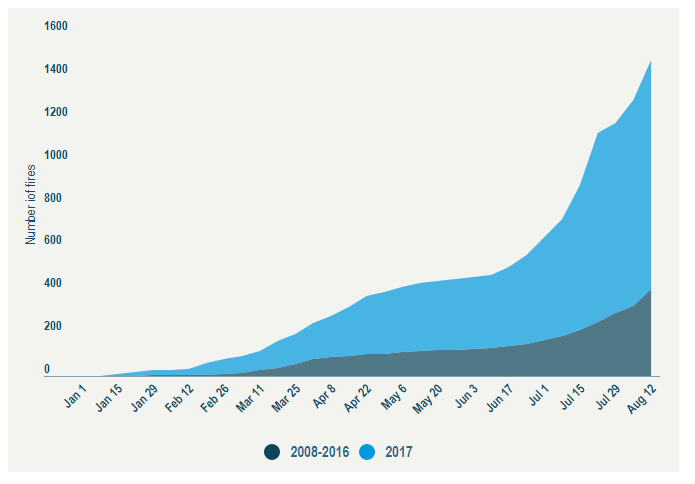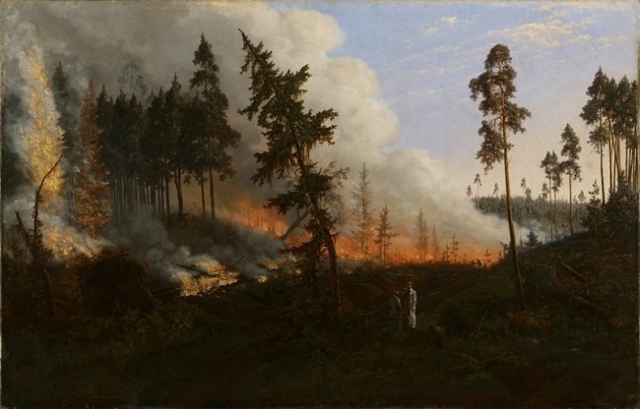The Long, Hot Summer: Why the Spike in Forest Fires & What Can Be Done
The ISET Economist, a blog about economics in Georgia and the South Caucasus by the International School of Economics at TSU (ISET)
By Mariam Chachava and Norberto Pignatti
In the summer of 2017, Georgia experienced an unusually high number of forest fires across the entire country. 35 forest fires were recorded in August alone (official data reporting the size of area burned by these fires is not yet available). In almost all regions of the country, several fires were reported. Among them, the conflagration in the Borjomi gorge had the most dramatic consequences: it lasted for seven days (20-27 August), and more than 100 hectares of forest were destroyed. Many people claim that these cannot all be accidental events. Is this necessarily so, or are there other, more plausible explanations?
What is certain is that, whatever the causes, forest fires can lead to extremely high economic, social and environmental costs. While it may be impossible to completely prevent forest fires from occurring, proper forest management, and the adoption of legislation providing proper incentives for stakeholders to take better care of forests and to avoid behaviors increasing the risk of forest fires, can do a lot to improve the situation. In this article, and in the follow-up that we’ll publish in the coming weeks, we’ll explore the factors that increase the risk of natural and Man-made fires, and discuss possible mitigating strategies, based on economic theory and international best practices. In today’s article, we will focus on natural forest fires.
Looking at data from 2017, one can see that throughout the year, the occurrence of forest fires has been alarmingly high all over the world. According a report by NASA (2017), dozens of forest fires happening in the USA can be seen in a Terra satellite image. According to the report, the number of fires occurring is much higher than it was during previous years. The authors claim that the fires were mostly due to hotter and drier natural conditions. European countries have also been suffering from an unusually high number of forest fires during 2017. According to Euronews, the number of forest fires in European countries in 2017 has been, so far, three times higher in comparison to the 2008-2016 average (see Graph #1). Euronews attributes the main reason for increased forest fires to climate change, especially the higher temperatures.

Graph #1. The Number of EU Forest Fires (2017 VS 2008-2016). Source: European Forest Fire Information System (EFFIS)
Scientific literature also supports the idea that the evolution of natural conditions during the last few years can justify an increase in the number of forest fires.
Existing weather conditions and the likelihood of forest fires are both affected by climate changes, which can potentially increase the risk of fires for several reasons:
- As a result of global warming, there are longer hot seasons. Warm weather arrives earlier, meaning that snowmelt starts earlier, and the ground stays dry for a longer period of time. This results in hotter summer months, and warm weather conditions extend further in autumn. Consequently, there is a longer fire season during the year.
- Higher temperatures lead to drier conditions in nature; this promotes evaporation and soil becomes less water-saturated. These circumstances increase not only the probability of fire occurrence, but also makes it harder to fight fire, because it spreads faster.
- Longer, drier and warmer seasons may favor the proliferation of destructive insects, helping them to survive winter and rapidly reproduce. These pests can cause tree death, making them drier and easier to ignite. In this way, more fuel for forest fires is created.
- Along with climate change, there have been more severe thunderstorms happening around the world, which increases the probability of lightening, and consequently increases the risk of forest fires.
Given the increased risk of wildfires associated with existing climate trends, developing and implementing more effective policies against such phenomena becomes an even greater priority. So, what can be done to more effectively prevent and fight wildfires? Here are some possible directions to pursue:
- Clear forests of easily flammable materials, including dry trees and grasses, because these materials are easily ignited in high temperatures.
- Invest in the recruitment and training of an adequate number of individuals in charge of fighting and preventing wildfires, as well as in providing them with the necessary equipment, and in building proper infrastructure, including forest roads.
- Improve the country’s readiness to fight natural disasters. This means funding more sophisticated monitoring, prevention and communication systems. For example, the government can develop and use probabilistic models, allowing them to make predictions about the risk of wildfires weeks and sometimes even months ahead. In this way, available resources may be more effectively deployed and concentrated where fire risks are higher. This, in turn, would require building more sophisticated real-time information collection systems monitoring the evolution of landscape, local climate and weather conditions.
- Take steps to reduce CO2 emissions (recognized as one of the main reasons for global warming). In fact, many world governments, including the Georgian one, have subscribed to the Paris Agreement, which has as its main focus global warming, and have pledged to adopt initiatives aimed at containing greenhouse gases. Among other things, governments can encourage people to increase their share of renewable energy sources in their total energy consumption; set limits, beyond which producers are not allowed to pollute; raise carbon-taxes based on carbon emission (with fuels leading to more emissions being taxed more heavily); and, fight deforestation (because cutting and burning trees not only reduces the absorption capacity of the environment, but also releases more carbon dioxide into the atmosphere). The last is a particularly relevant issue in Georgia: the illegal cutting (and burning) of trees is not rare. Limiting global warming could also help stop a vicious cycle in which more fires cause more carbon emission (and less carbon absorption), which in turn leads to more global warming and so on.
The Estonian Example
Estonia is a good example of how it is possible to implement successful policies in order to prevent wildfires. In 2002 and 2006, Estonia experienced a dramatic spike in forest fires (the majority of them were naturally caused). In 2009, the government decided to implement policies to fight forest fires. These policies focused mostly on the training of local communities and individuals who were in charge of fighting wildfires. Training was important in order to increase communities’ awareness of the risks of natural fires, and to increase the number of volunteers fighting wildfires. Firefighters were also trained to expand their ability to prevent wildfires. The trainings included topics such as: what is the nature of forest fires, how to detect hot spots, and how to avoid their emergence. After the implementation of this policy, the number of forest fires declined (see Graph #2), as did the total extension of the area burned during fires.

Graph #2. Number of Forest Fires in Estonia (2000-2011). Source: Life + Information and Communication project (2012).
THE WAY AHEAD
In the short term, it is possible to fight and prevent natural forest fires by setting up a proper forest management system and having well-trained and well-equipped staff. Increasing social involvement in the process of preventing forest fires can also reduce the risk of wildfires and increase the number of volunteers during emergency situations.
In the long-run, and from a broader perspective, Georgia can also join the global efforts to reduce the level of greenhouse gas emissions, to which it has committed by signing the Paris Agreement. Joining this effort will contribute to the fight against climate change and thereby help reduce the occurrence of favorable natural conditions for forest fires, not only in Georgia but all over the world.











